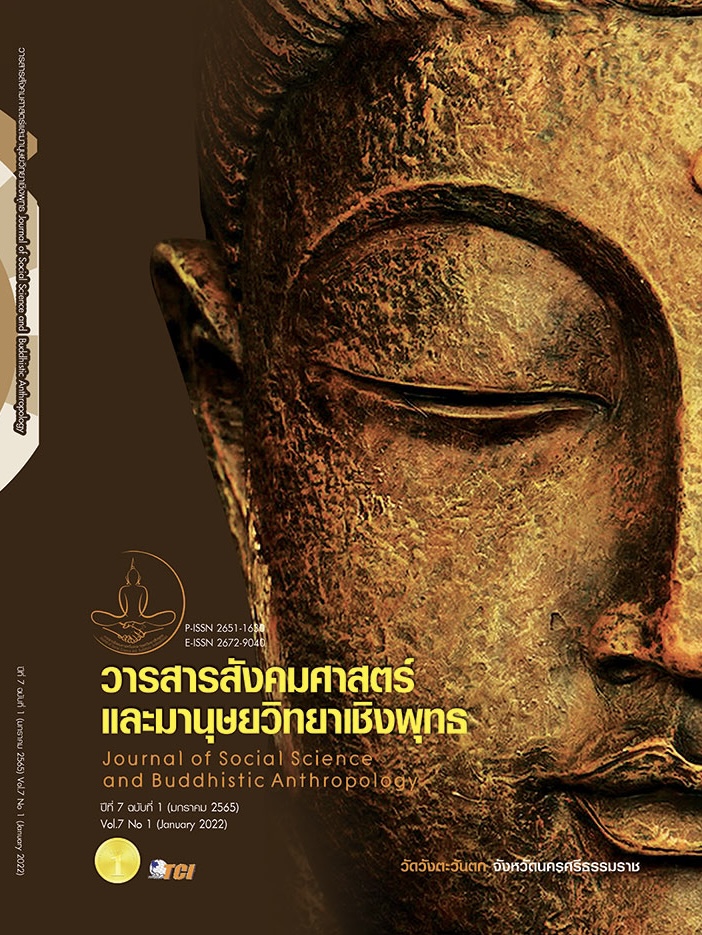INNOVOVATIVE LEADERSHIP COMPONENTS OF SCHOOL ADMINISTRATORS IN THE DIGITAL AGE
Keywords:
Components, Innovative Leadership, Administrators, Digital AgeAbstract
The objectives of this research article were to: 1) study Innovative Leadership Components of School Administrators in the Digital age, and 2) Check the consistency of the indicator structure model of School Administrators in the Digital age. This study was mix research method including quantitatively questionnaire stratified sampling with 280 administrators by analysis, frequency, percentage, mean, standard deviation, skew, and kurtosis. It was a qualitative of depth interview for specific sampling and the main informant was school administrators by connoisseurship of 7 qualified persons. In conclusion, the content analysis of research found that indicators of educational administrators in the digital era consist of 6 components and 20 indicators such as 1.1) creativity ( = 4.32, S.D. = 0.54) including initiative, agile, flexible, and thorough, 1.2) self-directed learning (
= 4.27, S.D. = 0.60) such as needs analyzing, set learning objectives, plan learning and seek scientific resources, 1.3) teamwork (
= 4.34, S.D. = 0.58) as communication, ability and activity, 1.4) integration (
= 4.38, SD. = 0.55) including with learning process, connect relationships and new knowledge, 1.5) technology in the digital age (
= 4.42, SD. = 0.54) such as develop talent, support budget, resources, and ethics, and 1.6) learning network (
= 4.42, SD. = 0.54) including collaborative a learning with stakeholders, create learning network, reflection and learning. And 2. an affirmative component model of educational administrators in the digital age is consistent with empirical data. The statistic was Chi-square = 1.32, df = 155, p = 0.94, GFI = 0.90, AGFI = 0.87, SRMR = 0.48, RMSEA = 0.00 and CFI = 1.00 that model was suitable and acceptable.
The objectives of this research article were to: 1) study Innovative Leadership Components of School Administrators in the Digital age, and 2) Check the consistency of the indicator structure model of School Administrators in the Digital age. This study was mix research method including quantitatively questionnaire stratified sampling with 280 administrators by analysis, frequency, percentage, mean, standard deviation, skew, and kurtosis. It was a qualitative of depth interview for specific sampling and the main informant was school administrators by connoisseurship of 7 qualified persons. In conclusion, the content analysis of research found that indicators of educational administrators in the digital era consist of 6 components and 20 indicators such as 1.1) creativity ( = 4.32, S.D. = 0.54) including initiative, agile, flexible, and thorough, 1.2) self-directed learning (
= 4.27, S.D. = 0.60) such as needs analyzing, set learning objectives, plan learning and seek scientific resources, 1.3) teamwork (
= 4.34, S.D. = 0.58) as communication, ability and activity, 1.4) integration (
= 4.38, SD. = 0.55) including with learning process, connect relationships and new knowledge, 1.5) technology in the digital age (
= 4.42, SD. = 0.54) such as develop talent, support budget, resources, and ethics, and 1.6) learning network (
= 4.42, SD. = 0.54) including collaborative a learning with stakeholders, create learning network, reflection and learning. And 2. an affirmative component model of educational administrators in the digital age is consistent with empirical data. The statistic was Chi-square = 1.32, df = 155, p = 0.94, GFI = 0.90, AGFI = 0.87, SRMR = 0.48, RMSEA = 0.00 and CFI = 1.00 that model was suitable and acceptable.
References
เชษฐา คล้าคล่อง. (2557). การพัฒนาโปรแกรมเสริมสร้างภาวะผู้นำแบบมุ่งบริการของผู้บริหารสถานศึกษาขั้นพื้นฐาน. ในดุษฎีนิพนธ์การศึกษาดุษฎีบัณฑิต สาขาวิชาการบริหารและพัฒนาการศึกษา. มหาวิทยาลัยมหาสารคาม.
ทิพมาศ เศวตวรโชติ. (2560). ตัวบ่งชี้ภาวะผู้นำแบบบูรณาการสำหรับผู้บริหารโรงเรียนมัธยมศึกษา สังกัดสำนักงานคณะกรรมการการศึกษาขั้นพื้นฐาน. วารสารสถาบันวิจัยญาณสังวร. 8(2), 166-176.
ธีระ รุญเจริญ. (2553). ความเปนมืออาชีพในการจัดและบริหารการศึกษา ยุคปฏิรูปการศึกษาเพื่อปฏิรูป รอบ 2 และประเมินภายนอกรอบ 3. ขอนแกน: สำนักพิมพขาวฟาง.
บุญชม ศรีสะอาด. (2556). วิธีการทางสถิติสำหรับการวิจัย เล่ม 1. (พิมพ์ครั้งที่ 5). กรุงเทพมหานคร: สุวีริยาการพิมพ์.
บัวพันธ์ ผิวทอง. (2556). รูปแบบการเสริมสร้างพลังอำนาจทรัพยากรมนุษย์ของโรงเรียน มัธยมศึกษาขนาดกลางในสำนักงานคณะกรรมการการศึกษาขั้นพื้นฐาน. ดุษฎีนิพนธ์การศึกษาดุษฎีบัณฑิต สาขาวิชาการบริหารการศึกษา มหาวิทยาลัยบูรพา.
ผู้บริหารโรงเรียนเขตที่ 10 (สัมภาษณ์). เรื่ององค์ประกอบภาวะผู้นำเชิงนวัตกรรมของผู้บริหารสถานศึกษาในยุคดิจิทัล. ชัดสกร พิกุลทอง (ผู้สัมภาษณ์) เมื่อวันที่ 12 สิงหาคม 2563.
ผู้บริหารโรงเรียนเขตที่ 11 (สัมภาษณ์). เรื่ององค์ประกอบภาวะผู้นำเชิงนวัตกรรมของผู้บริหารสถานศึกษาในยุคดิจิทัล. ชัดสกร พิกุลทอง (ผู้สัมภาษณ์) เมื่อวันที่ 12 สิงหาคม 2563.
ผู้บริหารโรงเรียนเขตที่ 12 (สัมภาษณ์). เรื่ององค์ประกอบภาวะผู้นำเชิงนวัตกรรมของผู้บริหารสถานศึกษาในยุคดิจิทัล. ชัดสกร พิกุลทอง (ผู้สัมภาษณ์) เมื่อวันที่ 12 สิงหาคม 2563.
ผู้บริหารโรงเรียนเขตที่ 13 (สัมภาษณ์). เรื่ององค์ประกอบภาวะผู้นำเชิงนวัตกรรมของผู้บริหารสถานศึกษาในยุคดิจิทัล. ชัดสกร พิกุลทอง (ผู้สัมภาษณ์) เมื่อวันที่ 12 สิงหาคม 2563.
ผู้บริหารโรงเรียนเขตที่ 14 (สัมภาษณ์). เรื่ององค์ประกอบภาวะผู้นำเชิงนวัตกรรมของผู้บริหารสถานศึกษาในยุคดิจิทัล. ชัดสกร พิกุลทอง (ผู้สัมภาษณ์) เมื่อวันที่ 12 สิงหาคม 2563.
เพ็ญจันทร สินธุเขต. (2560). การศึกษายุคนี้ (ยุคดิจิทัล): Thailand 4.0. รายงานสืบเนื่องการประชุมวิชาการและการนำเสนอผลงานวิจัยระดับชาติ (Conference Proceedings) ครุศาสตร์วิจัย ครั้งที่ 3: 2560 นวัตกรรมแห่งการเรียนรู้.
สำนักงานคณะกรรมการการศึกษาขั้นพื้นฐาน. (2553). คู่มือการประเมินสมรรถนะครู. กรุงเทพมหานคร: ชุมนุมสหกรณ์การเกษตรแห่งประเทศไทย.
สำนักงานราชบัณฑิตยสภา. (2563). การแบ่งภูมิภาคทางภูมิศาสตร์. เรียกใช้เมื่อ 14 พฤษภาคม 2563 จาก http://www. royin.go.th/?knowledges.
สำนักงานรับรองมาตรฐานและประเมินคุณภาพการศึกษา. (2558). ผลการประเมินคุณภาพภายนอกรอบสาม. สมุทรปราการ: ออฟเซ็ท พลัส
อดิเรก พรสีมา. (2563). ผู้นำยุคนี้ต้องมี Digital Mindset. เรียกใช้เมื่อ 14 พ.ค. 2563 จาก https://www.bangkokbiznews.com/blog/detail/648785.
Cronbach, L. J. (1990). Essentials of psychological testing (5th ed.). New York: Harper Collins. Publishers.
Krejcie, R. V. & Morgan, D. W. (1970). Determining Sample Size for Research Activities. Educational and Psychological Measurement, 30(3), 607-610.
Likert R. (1967). “The Method of Constructing and Attitude Scale”. In Reading in Fishbeic, M (Ed.), Attitude Theory and Measurement (pp. 90-95). New York: Wiley & Son.
Sheninger. E. (2014). Digital Leadership: Changing paradigms for changing times. California: United States of America.
Downloads
Published
How to Cite
Issue
Section
License
Copyright (c) 2022 Journal of Social Science and Buddhistic Anthropology

This work is licensed under a Creative Commons Attribution-NonCommercial-NoDerivatives 4.0 International License.








